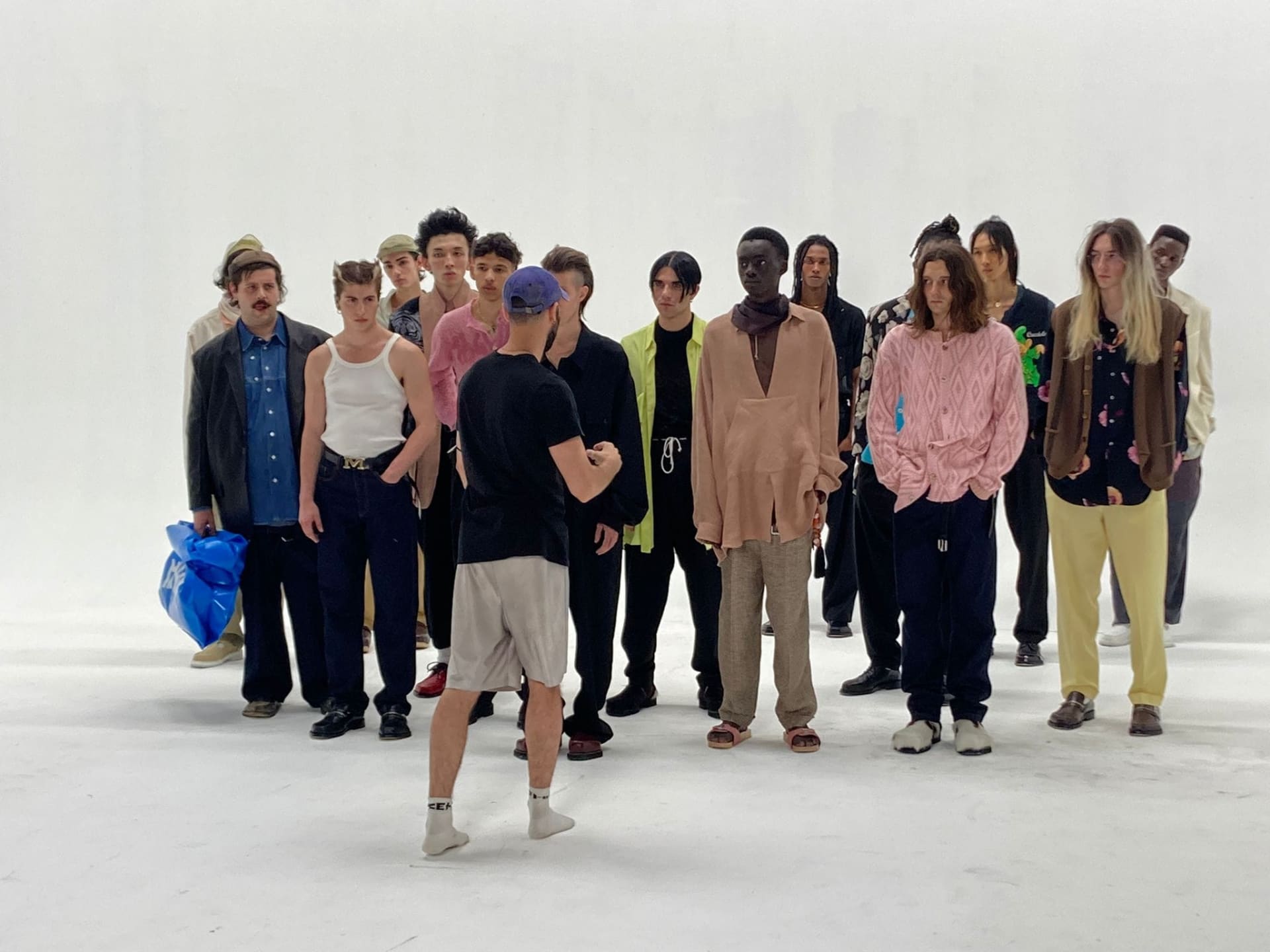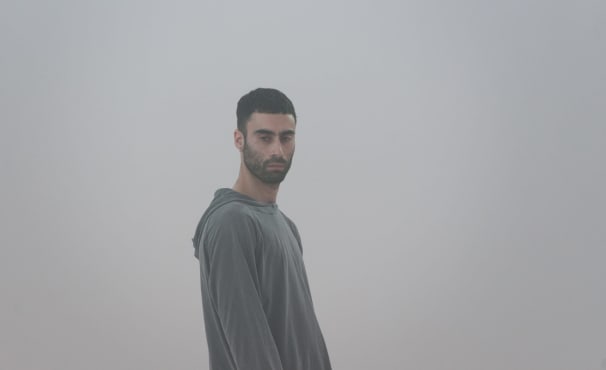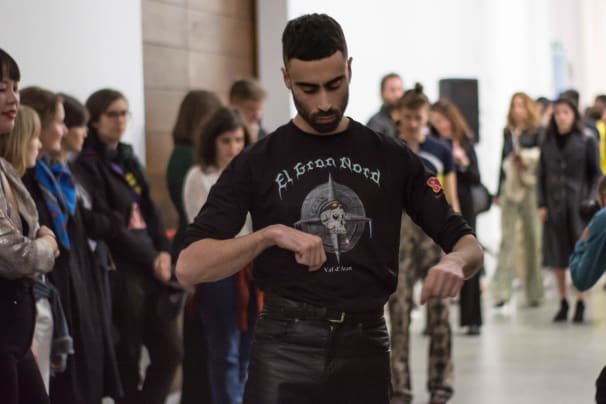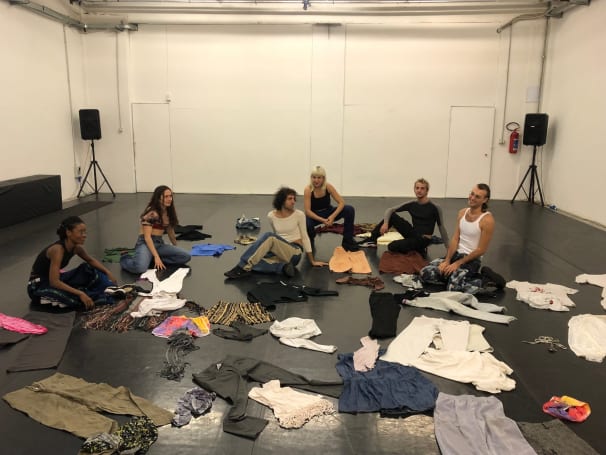
E-MERGING: Get to know Michele Rizzo and his hypnotic performance art
The Italian choreographer translates movement into a mesmerizing experience inspired by the club.
Text: Juule Kay
The world is changing, and with it, a new generation of trailblazers is taking over. In our monthly series E-MERGING, we introduce the people adding to the cultural moment with their creative minds, new ideas, and unique approaches. It’s a glimpse behind the scenes, a way to dig deeper and look beyond the picture-perfect outcome we’re swamped with every day.
You find yourself in a room full of people, some arriving early enough to get a front-row seat on the floor, others standing huddled up behind. A special kind of anticipation lies in the air; something familiar yet unknown is starting to unfold. One by one, the performers enter the space, captivating the audience with their cadenced steps, which slowly merge into a homogenous movement. Michele Rizzo’s viral, rave-infused project HIGHER xtn is all about the perfect synergy.


“I never went to the club with the idea of making a work out of it,” says the Italian artist and choreographer, who lives between Amsterdam and Milan, “but that experience inspired me to completely redefine my understanding of movement and dance.” Having been exposed to dance as an art form all his life, the club became a microcosm, offering a new way of learning about sociality and interactions between people and bodies. “It’s an experience with two ways of coexisting in the world: one is your experience with yourself, and the other is the communal aspect of it,” he continues to explain. “These two experiences fully merge into each other in a way that is difficult to grasp.” And yet, you can see it in the way the performers claim their own space while simultaneously being part of a broader vision––his vision.
“Sometimes I even surprise myself by the longevity of the project,” says the Italian artist jokingly. It’s almost been 10 years since Rizzo started this series of projects revolving around the experience of clubbing. A lot has happened in his career, including his work as a movement designer for high fashion brands like Marni, Off-White and Magliano. The art and fashion worlds often collide, and yet they have very different processes and ways of discovering and experimenting. “In my work as an artist, I can dig deeper because I have more time, and I am orchestrating the development,” explains Rizzo, who studied choreography and visual arts in Amsterdam. “In fashion, there are more rules, and it’s nice to challenge them, but it’s also me putting myself in service of a different perspective or a view that is not necessarily only my own.”
What I personally like the most is when I notice something that starts out of intuition.
For him, it’s all about the vulnerability of placing himself in new contexts. “When I started to work in fashion, I wasn’t really accustomed to this world,” he remembers. “I was fascinated by it, and I learned through it, and still do.” Pushing himself out of his comfort zone made Rizzo reanalyze his practice, focus more on research, and make his work feel strongly self-reflective. “I like the struggle because it’s a manifestation of a certain vulnerability, which implies a desire for learning,” Rizzo explains, referring to the selection of performers for his projects but somehow also rings true to himself. This might also be a reason why he rarely works with professional dancers rather than people who have a certain interest in movement. “What I personally like the most is when I notice something that starts out of intuition,” he continues. “From that moment on, I try to notice and observe how this thing morphs and changes. My way of creating evolves into attending to this process by nurturing it, taking it by the hand, and guiding it so that it can grow.”
Even though Rizzo adapts the role of the observer, he doesn’t want his audience to passively perceive his art. “Most of my work is watching something repeat over and over again or something unfold very slowly and gently,” he says. “Contemplation is very active because it requires you to almost decode what it is you’re just looking at.” While you are busy trying to make it all make sense, you almost forget about the music, which is a fundamental part of Rizzo’s work. According to the artist, music guides the experience as it unfolds in a performance: “Music is the texture of a space. It has this quality of manifesting the invisible and also allows whatever is personal and intimate to become public as it becomes audible and perceivable by others. In that sense, music has the capacity to expose the emotional core of any situation.”


What’s the best way to lose track of time?
Observing, listening closely, and getting lost in details.
If your art is a piece of clothing, how would you describe it?
As a prototype, still made on a body full of pins and needles.
What was the last fantasy you sculpted?
The idea of allowing space to emerge, and in order for space to emerge, I need to almost hide from space. Maybe I’m sculpting disappearance in some way.
How many stages of choreographic research exist for you?
The first stage is very introverted. It has to do with understanding what really matters to you at that moment. Then there’s a stage of curiosity arising, and then one of falling in love with something. It’s a very self-reflective process, which can be confronting at times.
What’s an uncommon place you’d love to see your work?
Somewhere in a forest or underwater.
Credits
Photography: Mattia Ruffolo, KLAK and Luca Ghedini
